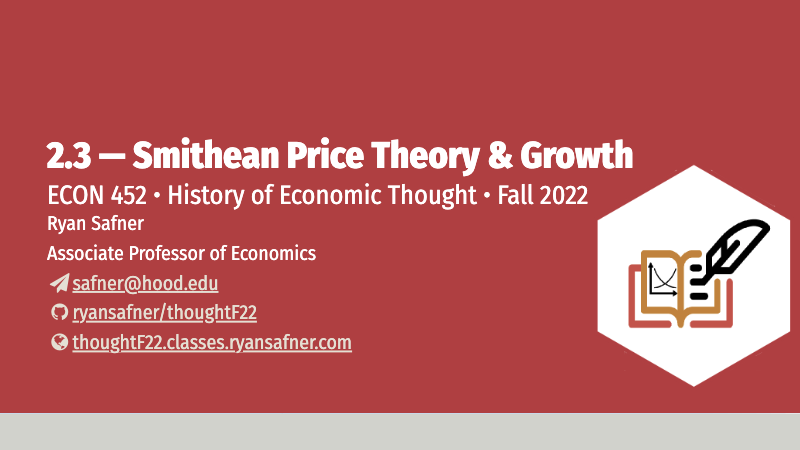2.3 — Smithean Price Theory & Economic Growth — Class Content
Overview
Today we dive into Smith’s analytical system, and some may say, the first organized discussion of economic analysis. The reading for Smith comes primarily from Book I: Of the Causes of Improvement in the productive Powers of Labour and Book II Of the Nature, Accumulation, and Employment of Stock and a little bit from Book V: Of the Revenue of the Sovereign or Commonwealth. Your reader focuses primarily on Book I and the division of labor (pp.156-165), which is great, but sadly lacks selections on capital from Book II or public finance from Book V.
It is a good idea whenever you can, to read as much of Books I1 and II as you can. You can find all of The Wealth of Nations online for free here:
Readings
Required Readings:
- Adam Smith’s Wealth of Nations: Books I-II excerpts in Reader (pp.156-165)
If You Hadn’t Yet:
- Ch.4 “Adam Smith” in Landreth & Colander
- Ch.2 “Adam Smith” in Blaug
Lastly, note the following useful tidbit, although he does use both words occasionally, “stock” is Adam Smith’s word for “capital.”
Recommended Readings:
The following Wikipedia entries can also provide more background:
Questions to Help Your Reading
Book I
- What is/are the “wealth of nations”?
- What is the division of labor? What limits or augments it?
- Explain Adam Smith’s famous pin factory example, and his woolen coat example.
- What three reasons does Smith give for why dividing our labor makes us more productive?
- Are our differences in talents a cause or a consequence of the division of labor? (Smith’s philosopher and the porter example.)
- Why and how did we discover the division of labor? Was it a conscious choice?
- What is the difference between “real” and “nominal” price?
- What are the “component parts” of the price of commodities?
- What differs between “rude” vs. “civilized” societies, and how does value & prices differ?
- What is the “natural price” vs. the “market price”?
- How are wages, profits, and rent determined?
Book II
- How does the division of labor depend on capital accumulation?
- What does Adam Smith view as “productive” vs. “unproductive” labor? Why? How does this differ from the physiocrats?
- What is capital and where does it come from? What is its purpose?
Slides
Below, you can find the slides in two formats. Clicking the image will bring you to the html version of the slides in a new tab. The lower button will allow you to download a PDF version of the slides.
You can type h to see a special list of viewing options, and type o for an outline view of all the slides.
I suggest printing the slides beforehand and using them to take additional notes in class (not everything is in the slides)!
Assignments
Participation/Discussion Board Posts Due 8 PM Fri Sep 30
This week’s graded discussion is worth 5 points, and can be a combination of discussion in class, and/or posts on the Blackboard Discussion Board by 8 PM this Friday September 30.
Tournament Votes
The first round of the Pre-Classical division of the “Most Interesting Economist in History” tournament is live. Please post your votes in the discussion board.
Footnotes
You can skip Smith’s difficult digression on silver in Chapter 11.↩︎
